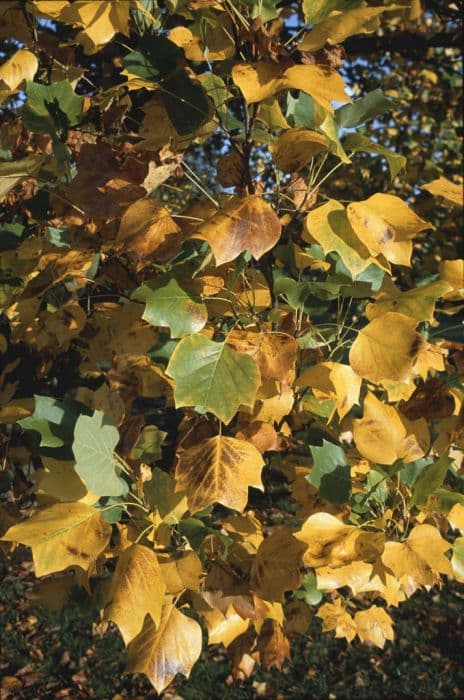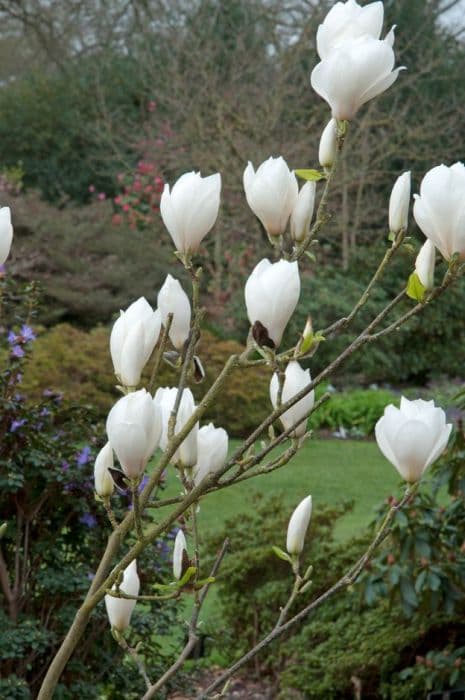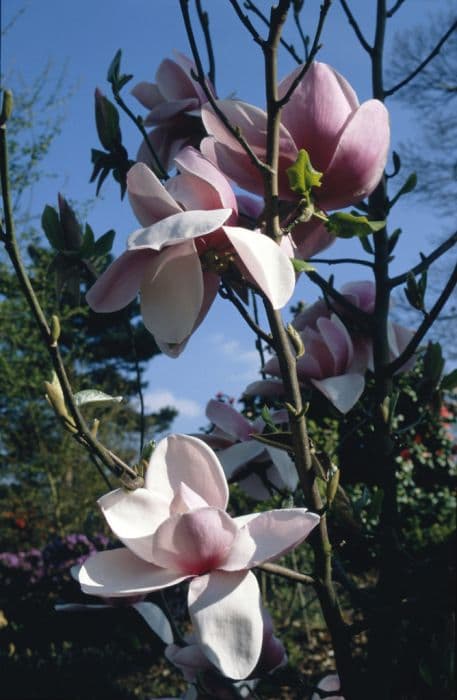Saucer Magnolia Magnolia 'Serene'

ABOUT
Magnolia 'Serene' is a captivating plant known for its magnificent flowers. The flowers are large, showy, and saucer-shaped with a creamy white to pale pink hue, often emitting a sweet, citrus-like fragrance that can be enjoyed from a distance. The petals are thick and waxy, overlapping in a tulip-like fashion, creating a stunning visual display when the plant is in full bloom. The leaves of Magnolia 'Serene' are glossy and dark green, providing a lush backdrop for the blossoms and enhancing their beauty. With its striking floral display and elegant foliage, this plant is a standout in any garden space where it graces the landscape with its serene and dignified presence.
About this plant
 Names
NamesFamily
Magnoliaceae
Synonyms
Serene Magnolia
Common names
Magnolia 'Serene'.
 Toxicity
ToxicityTo humans
Magnolia 'Serene', commonly known as Magnolia, is not widely recognized as a toxic plant to humans. While there are many plants that can be harmful if ingested, there is limited evidence to suggest significant toxicity in the Magnolia genus. As with many plants, certain individuals may have sensitivities or allergic reactions to parts of the plant, such as the flowers or leaves if ingested. However, these cases are relatively rare and generally, Magnolia 'Serene' poses little risk of serious poisoning to humans. If someone were to ingest a large quantity of any part of the plant and experience symptoms such as stomach upset, nausea, vomiting, or diarrhea, they should seek medical advice. It's always best practice to avoid eating any plant parts unless they are known to be safe for consumption.
To pets
Magnolia 'Serene', commonly known as Magnolia, is generally considered to be non-toxic to pets, including dogs and cats. The American Society for the Prevention of Cruelty to Animals (ASPCA) does not list the Magnolia genus as toxic to pets. Therefore, it is unlikely that ingesting parts of the Magnolia 'Serene' would result in significant toxic effects for your pets. Individual animals might experience mild stomach upset if they consume parts of the plant, such as leaves or flowers, in large amounts. Symptoms could include vomiting or diarrhea, but these are typically not severe. As with any non-food item, if a pet ingests a large amount of plant material and exhibits signs of distress, it is prudent to consult a veterinarian.
 Characteristics
CharacteristicsLife cycle
Perennials
Foliage type
Evergreen
Color of leaves
Green
Flower color
White
Height
10-20 feet (3-6 meters)
Spread
6-15 feet (2-5 meters)
Plant type
Tree
Hardiness zones
7-9
Native area
Southeast Asia
Benefits
 General Benefits
General Benefits- Ornamental Value: Adds aesthetic appeal with its large, showy flowers and glossy green leaves.
- Shade Provider: Can offer a cooling canopy in garden landscapes.
- Fragrance: The flowers emit a pleasant, sweet scent that can enhance the sensory experience of a garden.
- Habitat for Wildlife: Attracts pollinators like bees and butterflies, providing them with nectar.
- Year-Round Interest: Evergreen in many climates, offering visual interest throughout the seasons.
- Durable: Tolerant of various soil types and can withstand some urban pollution.
 Medical Properties
Medical Properties- This plant is not used for medical purposes.
 Air-purifying Qualities
Air-purifying QualitiesThis plant is not specifically known for air purifying qualities.
 Other Uses
Other Uses- Magnolia petals can be used for decorative purposes in culinary arts, such as garnishing salads or adorning cakes for a touch of natural elegance.
- The wood from Magnolia trees is sometimes used in furniture making for its attractive grain and color, although it is not as common as wood from other species.
- Dried Magnolia leaves can be utilized in crafts, such as wreath making, providing a rustic and durable decorating option.
- Ink made from Magnolia seed cones can create unique hues for art projects and calligraphy, offering artists a natural dye option.
- Magnolia blossoms are sometimes crystallized with sugar and used as sweet treats or cake decorations, showcasing the flower's versatility in desserts.
- Extract from the bark of Magnolia trees can be infused into candles and soaps for its fragrance, although this is a less common use.
- The large leaves of Magnolias can be used as natural wrapping material for small gifts or as part of eco-friendly packaging design.
- Pressed Magnolia flowers can be included in handmade paper production, imparting a unique texture and pattern to the finished product.
- Fallen Magnolia leaves are substantial enough to be used as temporary outdoor mulch, providing protection for garden soil and suppressing weed growth.
- The gentle scent of Magnolia flowers can be captured in homemade potpourri mixes, offering a subtle fragrance that can freshen up a space.
Interesting Facts
 Feng Shui
Feng ShuiThe Magnolia is often used in Feng Shui to promote purity, nobility, and a calm atmosphere due to its elegant and serene flowers. It can be planted in the garden to invite positive energy, or its image can be displayed in the living room or bedroom to enhance relaxation and tranquility.
 Zodiac Sign Compitability
Zodiac Sign CompitabilityThe Magnolia is not used in astrology practice.
 Plant Symbolism
Plant Symbolism- Purity: The magnolia flower is often associated with purity due to its clean and flawless appearance.
- Nobility: With its impressive size and stature, the magnolia often symbolizes dignity and a sense of nobility.
- Perseverance: Since magnolia trees are known to be resilient and long-lived, they represent perseverance and endurance through life's challenges.
- Femininity: The delicate and graceful form of the magnolia flower can be seen as a representation of femininity and beauty.
- Hospitality: In the American South, magnolias are a symbol of hospitality, welcoming and warmth.
 Water
WaterThe Southern Magnolia should be watered deeply, allowing for thorough soil saturation. This deep watering promotes deep root development and should be performed slowly to allow the water to penetrate the ground rather than running off. In the first year, water the Southern Magnolia once a week with approximately 1.5 to 2 gallons of water, making adjustments based on rainfall and soil type. Once established, water every two to three weeks, depending on weather conditions and soil moisture. Always reduce watering frequency in cooler months and increase during prolonged dry spells or extreme heat.
 Light
LightSouthern Magnolias thrive in full sun to partial shade. Best growth and flowering occur in a spot that receives at least 4 to 6 hours of direct sunlight daily. An ideal location would have morning sun and afternoon shade, especially in the hottest regions.
 Temperature
TemperatureSouthern Magnolias are hardy and can tolerate a wide range of temperatures, from about 20°F in the winter to over 90°F in the summer months. They flourish in an ideal temperature range between 70°F and 90°F. To avoid cold damage, do not plant in areas where temperatures regularly drop below 20°F.
 Pruning
PruningPrune Southern Magnolias to maintain shape and remove any dead or damaged branches. The best time for pruning is after the tree has finished blooming, generally in late spring or early summer. Prune sparingly, as magnolias do not require heavy pruning and can be sensitive to over-pruning, which may reduce flowering the following season.
 Cleaning
CleaningAs needed
 Soil
SoilMagnolia 'Serene', commonly known as the Magnolia, thrives best in a moist, well-draining soil mix that is rich in organic matter. A recommended soil recipe might include equal parts loamy soil, compost, and pine bark to create an acidic to neutral pH environment, optimally between 5.5 and 7.0.
 Repotting
RepottingThe Magnolia 'Serene' typically needs repotting every 2 to 3 years to replenish the soil and provide room for growth, doing so in the spring before new growth begins is ideal.
 Humidity & Misting
Humidity & MistingThe Magnolia 'Serene' prefers moderate to high humidity levels but is adaptable and can tolerate lower humidity conditions commonly found in residential settings.
 Suitable locations
Suitable locationsIndoor
Place in bright, indirect light and ensure soil drainage.
Outdoor
Plant in sun to partial shade; protect from strong winds.
Hardiness zone
7-9 USDA
 Life cycle
Life cycleMagnolia 'Serene' begins its life when a seed germinates, typically requiring warm, moist soil conditions to initiate growth. As a seedling, it establishes a root system and begins to sprout leaves, relying on nutrients stored in the seed until it can photosynthesize. It then transitions to a juvenile stage, where it focuses on vegetative growth, developing a sturdy trunk and branching structure. Once mature, which can take several years, it enters the reproductive stage, characterized by the production of large, fragrant flowers that are typically white or cream-colored. Following pollination, flowers develop into cone-like fruit that releases seeds, completing the reproductive cycle. The Magnolia 'Serene' can live for many decades, continually going through annual growth cycles and producing flowers each year, typically in the spring.
 Propogation
PropogationPropogation time
Spring-Early Summer
The most popular method for propagating the Magnolia 'Serene' is by softwood cuttings. This is typically done in late spring to early summer when new growth is still flexible. To propagate, a cutting should be taken from a healthy branch, making sure it includes at least 2-3 nodes and is about 4-6 inches in length (approximately 10-15 cm). The lower leaves are removed, and the cut end is dipped in rooting hormone to increase the chances of successful root development. The prepared cutting is then placed in a well-draining soil mix, kept moist, and covered with a plastic bag or placed in a greenhouse to maintain high humidity around it. Roots might start forming within a few weeks, after which the new Magnolia can eventually be transplanted into the garden.









